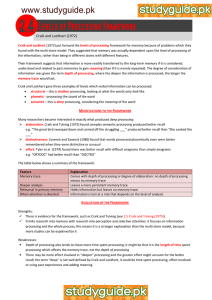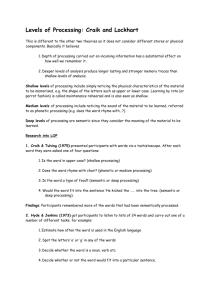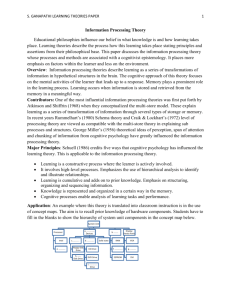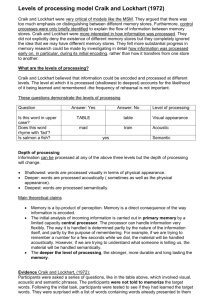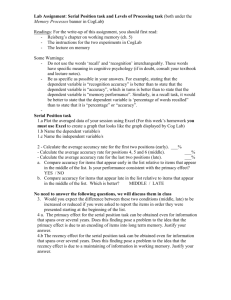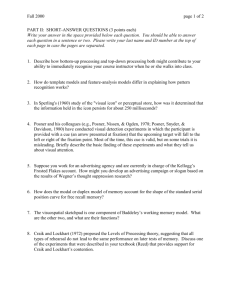Timothy A. Salthouse
advertisement
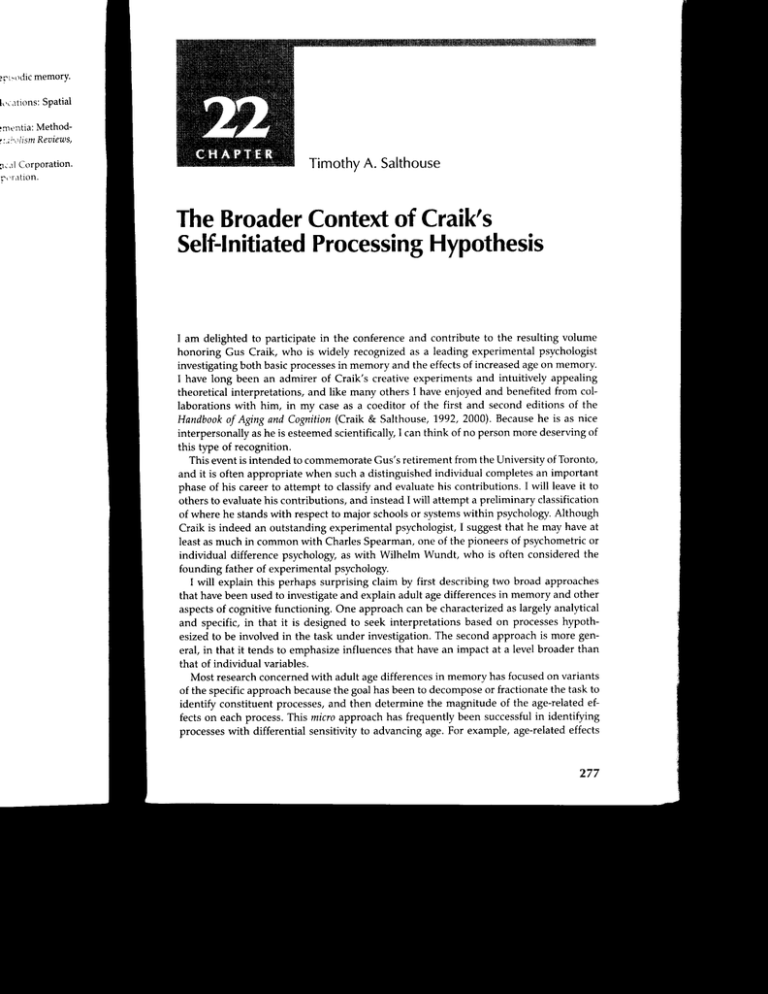
taL:()dicmemory.
l.'rrtions: SPatial
fn1('ntia:MethodReoiews,
t:.;':,.lism
lr.rl Corporation.
r,,ration.
TimothyA. Salthouse
TheBroaderContextof Craik's
Hypothesis
Self-lnitiatedProcessing
I am delighted to participate in the conference and contribute to the resulting volume
honoring Gus Craik, who is widely recognized as a leading experimental psychologist
investigatingboth basic processesin memory and the effectsof increasedage on memory.
I have long been an admirer of Craik's creative experiments and intuitively appealing
theoretical interpretations, and like many others I have enjoyed and benefited from collaborations with him, in my case as a coeditor of the first and second editions of the
Handbookof Aging and Cognition(Craik & Salthouse, 1992, 2000). Becausehe is as nice
interpersonally as he is esteemedscientifically,I can think of no person more deserving of
this t)?e of recognition.
This event is intended to commemorateGus's retirement from the University of Toronto,
and it is often appropriate when such a distinguished individual completesan important
phase of his career to attempt to classifyand evaluatehis contributions. I will leave it to
others to evaluatehis contributions, and instead I will attempt a preliminary classification
of where he stands with respect to major schools or systems within psychology. Although
Craik is indeed an outstanding experimental psychologist,I suggestthat he may have at
least as much in common with Charles Spearman,one of the pioneers of psychometricor
individual difference psychology, as with Wilhelm Wundt, who is often considered the
founding father of experimental psychologr.
I will explain this perhaps surprising claim by first describing two broad approaches
that have been used to investigateand explain adult age differencesin memory and other
aspectsof cognitive functioning. One approach can be characterizedas largely analytical
and specific, in that it is designed to seek interpretations based on Processeshypothesized to be involved in the task under investigation. The second approach is more general, in that it tends to emphasize influences that have an impact at a level broader than
that of individual variables.
Most researchconcernedwith adult age differencesin memory has focused on variants
of the specificapproach becausethe goal has been to decomposeor fractionatethe task to
identify constituent processes,and then determine the magnitude of the age-relatedeffects on each process. This micro approach has frequently been successful in identiS'ing
processes with differential sensitivity to advancing age. For example, age-related effects
278
Perspectives
on Human Memory and CognitiveAging
are typically greater on controlled processesthan on automatic processes,and on processesassociatedwith explicit memory than on processesassociatedwith implicit memory.
The micro perspectiveis representedin this volume by the contributions of Jacoby,Marsh,
and Dolan (chapter19); McDowd (chapter11);Naveh-Benjamin(chapter15); and Koustaal
and Schacter(chapter 30).
The alternative macroapproach tends to emphasizeage-relatedeffects that operate on
severaldifferent tyPes of variables.These broader influences may be related to effectson
a critical processor theoretical construct, such as encoding or goal maintenance, or they
may be linked to an attribute such as working memory capacity,effectivenessof deploying or inhibiting attention, or speed of processing.The common feature of these more
generalperspectivesis that they postulatethat at least some of the age-relatedeffectson a
given variable are not specific to that variable, but instead are shared with several different kinds of variables.
Figare 22.1 contains a schematic illustration of the micro and macro perspectivesin
cognitive aging. The top panel portrays the decomposition of a variable into a number (in
this case,three) of hypothesized processesor components, and the bottom panel represents age-related effects operating on several different types of cognitive variables.
Although much of Craik's researchhas attempted to fractionatememory tasks to isolate
the age-relatedeffects to specific processes,he has also been sympathetic to, and sometimes even an ardent advocateof, the macro or general perspectivebecausehe has hy-
Micro
^,-4
r,
*\-T",2-
l P a l l P B ll P c l
>4
M i q E M
Decomposethe task into constituentprocesses,and examinethe
age sensitivityof each component
Macro
Examineage-relatedinfluencesthat simultaneously
operate
on several differentvariables
FIGURE22.1. Schematicillustrationof micro (decompositional)and macro (integrative)
approachesto investigating
adult age differencesin cognition.
I
pothesizedthat in addition to task-spe
on some form of processingresourcet
different types of memory tasks. Crai
(e.9.,1927\becauseboth he and Spt
variables representing different cognr
tion of general and specific influencel
have used the term mental energVto re
eral influences. However, they differ i
people and acrossvariables.
As most psychologists know, Spean
general factor manifested in different r
ably related to the amount of mental e
of g is self-initiated processing (some
required in different amounts acrossI
presumably related to the amount of r
1986) portrayed his self-initiated prcre
rows representeddifferent memorv t:
of self-initiated processingincreased
differences.A major goal of the hrlxr{
tude of age differencesin memon' r'ar
ferences,with progressivelylarger drff
and finally the largestagedifferencesfr
processinghypothesisis the notion of r
along the self-initiated processingdrm
ing amounts of environmental suppro
etc., that serve to reduce the nmount r
task, and hence also to decreasethe n
Craik's self-initiatedprocessinghrR
aging phenomena might be explaina
understood.The concept of self-initra
ber of other proposals such as control
cessing, and reflective processing. ln
hypothesizedto differ in the amount ol
and on average,the eftectivenessof c
decreasewith increasingage. Each of t
difficulties of how to operationalizethr
measuresof the construct to avoid pr
construct is inferred from the same Fu
Craik and his colleagues have ret-t6
them in a number of ingenious erp'e
found that when researchparticipants
a memory task not only were older ad
ment to perform the two tasks simulta
larger for a free recall memort' tasl t
ivere replicated and extended in a :t-n
Beniamin (1998),in which the secon&
cued recall to recognition. The discove
of memory tasks can be predicted fr'
presumed to reflect self-initiated pro
Craik's self-initiated processinghrprt:
Craik'sSelf-lnitiated
ProcessingHypothesis
.r:lJ on Prol r t r :n t e m o n ' .
r c , , l . r\ .1 a r s h .
a:'J Koustaal
li
"''.t'rc-lt€
OII
t., ( llects on
a:'. ! ')r the\
: Jcplor'. .._r,(,nt()fr,
ti r iir'r ts Oft .t
rr '. . '.t I eliiterrI -'.-r ! t lVC\
ln
. ' )" . ; : r ' r b t r I l n
:'.r:'r; rcPrel:.1 l' r .
i.\.',,
.
.l
tr(rl.ttc
-J
.1rP11'
:. :', ir.t: ht -
279
pothesizedthat in addition to task-specificprocesses,there are also age-relatedinfluences
on some form of processingresourcethat is needed for the effectiveperformance of many
different types of memory tasks. Craik can therefore be considered similar to Spearman
(e.9., 1927) becauseboth he and Spearman have argued that individual differences in
variables representing different cognitive tasks or abilities are attributable to a combination of general and specific influences. Spearman and Craik are also similar in that both
have used the term mental energyto refer to the basis of individual differences in the general influences. However, they differ in their proposals about what it is that varies across
people and acrossvariables.
As most psychologistsknow, Spearman proposed the concept of g, which refers to the
generalfactor manifestedin different degreesacrossmost variablesand which is presumably related to the amount of mental energy availableto an individual. Craik's equivalent
of g is self-initiated processing (sometimesreferred to as SIP), which he hypothesized is
required in different amounts acrossdifferent types of memory tasks, and which is also
presumably related to the amount of mental energy an individual possesses.Craik (e.g.,
1986)portrayed his self-initiatedprocessinghypothesisin the form of a table in which the
rows representeddifferent memory tasks and the columns indicated that as the amount
of self-initiated processing increased, so did the expected magnitude of the age-related
differences.A major goal of the hypothesiswas to account for an ordering of the magnitude of age differencesin memory variables,ranging from priming with the smallestdifferences,with progressivelylarger differencesfor relearning, recognition, and cued recall,
and finally the largestage differencesfor free recall. Another aspectof Craik's self-initiated
processinghypothesisis the notion of environmental support becausesuccessivepositions
along the self-initiated processingdimension were postulated to be associatedwith varying amounts of environmental support. This support existed in the form of cues, context,
etc., that serve to reduce the amount of self-initiated processingrequired to perform the
task, and hence also to decreasethe magnitude of the resulting age-relateddifferences.
Craik's self-initiatedprocessinghypothesisis intriguing becauseit implies that memory
aging phenomena might be explained once the nature of self-initiated processing was
understood.The concept of self-initiated processingsharessome similarities with a number of other proposals such as controlled processing,effortful processing,deliberate processing, and reflective processing. In every case, memory or other cognitive tasks are
hypothesizedto differ in the amount of this processingneededfor successfulperformance,
and on average/the eftectivenessof carrying out this type of processingis postulated to
decreasewith increasing age. Each of these proposalshas plausibility, but they all face the
difficulties of how to operationalizethe relevant construct and how to obtain independent
measuresof the construct to avoid problems of circularity in which the existence of the
construct is inferred from the same pattern of results that it is supposed to explain.
Craik and his colleagueshave recognized these issuesand have attempted to deal with
them in a number of ingenious experiments. For example, Craik and McDowd (1987)
found that when researchparticipants were asked to perform a reaction time task during
a memory task not only were older adults slowed more than young adults by the requirement to perform the two tasks simultaneously,but the reaction times in both groups were
larger for a free recall memory task than for a recognition memory task. These results
were replicated and extended in a seriesof experiments by Anderson, Craik, and NavehBenjamin (1998),in which the secondaryreaction time costsdecreasedfrom free recall to
cued recall to recognition. The discoverythat the magnitude of age differenceson a series
of memory tasks can be predicted from a variable (i.e., secondary task reaction time)
presumed to reflect self-initiated processing demands provides impressive support for
Craik's self-initiated processinghypothesis.
280
I
on Human Memory and CognitiveAging
Perspectives
of adult
In the remainder of this article I will describe a different approach to the study
different
quite
a
with
I
will
start
variables.
cognitive
age differences in memory and other
up with an
qirestion and will rely on a different methodological approach, but I will end
hypothesis'
self-initiated
by
Craik's
implied
that
to
Processing
similar
function
"rr.,piricat
selfIn order to highlight the correspondence between my apProach and the Craikian
graph
the
into
hypothesis
Craik's
transform
will
first
initiated pro.Jrsi.,g hypothesis, I
related to
portrayed' in ftg"re ZZ.iin which self-initiated processing and age are positively
along the
one another, and different memory variables are located at different positions
hypothesis,
Craik's
of
principle
key
the
function. Note that this representalion embodies
pronamely, that there is a sysiematic relationship between the amount of self-initiated
it is easier
cessing required and the magnitude of the age differences on the variable, but
to illustrate the similarity to my approach with this form of lePresentation.
two types
A fundamental assumption of my perspective is that all variables have at least
variable and
particular
to
a
specific
are
that
iniluences
unique
influences:
of age-related
I also
shared influences that are common to many different types of cognitive variables'
with
age
relation
of
their
magnitude
total
assume that not only do variables differ in the
varisome
that
such
influences,
of
types
two
of
the
but also in the relative contributions
have largelv
ables primarily have unique age-related influences, whereas other variables
twes of influences, but it is simplest
what can be termed the shared infl
Hambrik, & McGuthry, 1998).The tu
the variance that all variables have u
statisticalproceduressuch as princip
equation modeling. The next step in t
mon variancebeforeexaminingager
on individual variables in this h'pe of
variables have in common correspor
effects that are mediated through the
lvtical method is not necessarilvinfo
different cognitive variables, but it d
encesto be partitioned into unique rd
Application of the method can be ill
and Rhee (1996),which involved 259
variableswere examined in this studv
shared influences.
of the two
Several analytical methods can be used to estimate the relative contributions
TABTE
22.1. Proportionsof total, C|.
Fristoe,and Rhee(1996)
Salthouse,
:
FreeRecall
Self
lnitiated
Processing
Magnitude
of
Age
Difference
CuedRecall
Recognition
Relearning
Priming
ot
'6
o
o
o
o
.
'
Free Recall ,j
j
Cued Recall
n
E
o
o
Recognition
'=
Ic)
a
Relearning
,-'
i
,
.
'
Priming ...
AbsoluteAge Correlation
processinghypothesis'
reoresentationof Craik'sself-initiated
FICURE22.2. Alternative
Variable
Total
RVLT2
RVLT6
Recog
P,\1
PA2
WCST
TrailsA
TrailsB
Shipley
BlkDes
ObjAssm
DigSym
LetCom
PatCom
.220
.199
.108
.261
.123
.167
.256
.348
.199
.219
.170
.429
Median
.220
-z1-t
.436
,!ote: RVLT2refers to the number oi
LearningTest;RVLT6to the numbero
the ReyVerbal LearningTest;Recoqt
PA1 and PA2 to the nu
LearningTest;
WCSTto the nur
of oairedassociates;
SortingTest,TrailsAand TrailsBto the tr
of the TrailMakingTest;Shipleyto the
Instituteof LivingScale;BlkDesto the
object assemblyscore from the \\ \
from the WAIS-R;LetComto the num
and PatComto the number of itemsc
articlefor detailson thesetests.
C r a i k ' s S e l f - l n i t i a t e d P r o c e s s i n g H y p o t h e s 2i s8 1
d:::.:.-:
t \\::: --:F\:.1-.h< .:.,:':
:eiJ:r -: :
l L ' : . : . -t
r \ : : ' 1- . ai(.::-:
ll
il\
-
-jt .
iar.. -,-:
le. .: -.
i't
types of influences, but it is simplest to illustrate how the estimates can be derived with
what can be termed the shared influences method (see Salthouse, 1,998;Salthouse,
Hambrik, & McGuthry, 1998).The first step in this procedure is to obtain an estimate of
the variance that all variables have in common. This can be achieved with a variety of
statisticalproceduressuch as principal components analysis,factor analysis,or structural
equation modeling. The next step in the procedure is to control an estimate of this common variance before examining age-related effects on individual variables. Effects of age
on individual variables in this type of analysis that are evident after controlling what the
variables have in common correspond to direct or unique age-relatedeffects, whereas
effects that are mediated through the common factor represent shared effects. This analytical method is not necessarily informative about the nature of what is shared among
different cognitive variables, but it does provide a means of allowing age-related influencesto be partitioned into unique (direct) and shared (indirect) aspects.
Application of the method can be illustrated with data from a study by Salthouse, Fristoe,
and Rhee (1996),which involved 259 adults between 19 and,94years ofage. A total of 14
variableswere examined in this study, including three measuresof episodicmemory from
. , 1 -i r . .
tl::1
:.\
TABLE22.1.Proportionsoftotal,shared,anduniqueage-relatedvariancefromstudyby
Salthouse, Fristoe, and Rhee (1996).
Age-relatedvariance (r2)
Shared
Unique
.436
.217
.196
.096
.257
.114
.166
.256
.344
.184
.216
.167
.418
.241
.395
.003
.003
.o12
.004
.009
.001
.000
.004
.015
.003
.003
.011
.002
.o41
.220
.220
.004
Variable
Total
RVLT2
RVLT6
Recog
PAl
PA2
WCST
TrailsA
TrailsB
Shipley
BlkDes
ObjAssm
DigSym
LetCom
PatCom
.220
.199
.108
.261
.123
.167
.256
.348
.199
.219
.170
.429
Vedian
.z+-)
lotei RVLT2refersto the number of words recalledin the second trial of the ReyVerbal
LearningTest;RVLT6to the number of words recalledin the sixth(postinterference)
trial of
the ReyVerbalLearningTest;Recogto the score in the recognitiontest of the ReyVerbal
LearningTest;PA1 and PA2to the number of responsetermscorrectlyrecalledin two lists
of pairedassociates;
WCSTto the number of categoriescompletedin the WisconsinCard
SoitingTest,TrailsAand TrailsB
to the time neededto completeversionsA and B, respectively,
of the TrailMakingTest;Shipleyto the abstraction(seriescompletion)scorefrom the Shipley
Instituteof LivingScale;BlkDesto the block designscorefrom the WAIS-R;ObjAssmto the
object assemblyscore from the WAIS-R;DigSym to the digit symbol substitutionscore
irom the WAIS-R;LetComto the number of itemscompletedin the lettercomparisontest;
,ind PatComto the number of itemscompletedin the patterncomparisontest.Seeoriginal
,rrticlefor detailson thesetests.
282
Perspectives
on Human Memory and CognitiveAging
Crark
the Rey Auditory Verbal Learning Test: free recall on the second trial, free recall after an
interference list, and recogrrition. The estimate of the common variance in the shared
influence analysis was based on the (unrotated) first principal component obtained faom
a principal components analysis on the 14 variables. Table 22.1.contains the total agerelated variance and the estimates of shared and unique age-related variance for each
variable. Notice that the median proportion of age-related variance across the L4 variables
was .220, which corresponds to an age correlation of -.47. However, the median proportion of unique age-related variance was only .004, which is less than 2"/"of the total agerelated variance and corresponds to an (absolute) age correlation of .06. The results summarized in Table 22|1. are typical of many analyses of this type because it has frequently
been found that only a small proportion of the total age-related effects on a given variable
are unique to that variable and independent of the age-related effects on other variables
(e.g.,Salthouse,'1.998,2001;
Salthouse,et al., 1998).
An interesting implication of the finding that a large proportion of the age-related effects on one variable is shared with the age-related effects on other variables is that there
should be a positive relation between the magnitude of the age relation on a variable and
the degree to which that variable is related to other variables. That is, if large proportions
of the age-related effects on different cognitive variables are shared, then the magnitude
of the age relation on a variable should closely correspond to the degree to which that
variable is related to, or has aspects in common with, other variables. Stated somewhat
differently, if a substantial amount of the age-related effects on a particular variable is
mediated through a factor representing what is common to all variables, then the size of
the age relation for that variable should be proportional to the strength of the relation
between the target variable and the common factor. This reasoning leads to the prediction
that there should be a strong positive relation between the absolute magnitude of the age
relation on the variable and the degree to which that variable is related to other variables.
I refer to these predicted functions as AR functions becausethe axesrepresentrelations of
the variable to age (A) and to relatedness (R).
The prediction of positive AR functions across different combinations of cognitive variables has recently received a considerable amount of empirical support. For example, Figure 22.3 illustrates the AR function with data from 14 variables in the Salthouse et al.
(1996) study (see Table 22|1. for a descript
corresponds to a single variable, with its al
and its loading on the first principal coml
mon to all variables, along the ordinate. I
tween the two sets of values, as the Pean
correlation was .81.
A similar pattern was evident in a later s
(1997), involving an independent sample r
variables. The data from this study are illus
the Pearson r was .83 and Spearman's ranJ
aspect of this latter study was that it inchx
cessing in a stem completion memorv task
tion procedure. Although the measure of r
cated close to the center of the AR functio
variables, the measure of automatic proce:
the function, indicating that the variable h
finding is therefore consistent with the ass
a qualitatively different type of processing
age-related effects are minimal to nonexis
ing. It is important to note that the autcr
respectablelevel of reliability (i.e., .82), ar
variables cannot be attributed to a low letr
able to be shared with other variables.
Similar patterns of positive AR function
tory, as the median rank-order correlation
phenomenon is not an artifact of differenu
lations were nearly the same magnitude
Salthouse,2001).Moreover, the phenomm
because it is evident in analyses of data 6
large-scale studies by Park and her collab
Saltr(r
Salthouse.Fristoe& Rhee ( 1996)
0.9
0.9
E
()
5 o.a
E
o
o
6
r=.84
rho = .81
0.7
E
o
6
aPAl
ob^ssma-./
'tr
(L
a
a
!
wcsT
U c
ne
o.s
3 oo
a
RVLT2
(L
o.a
5
oz
o
Shipley
a TrailsA
BlkD€sa a
RVLT6a
'o
.E 0.6
c
E
o
DigSym
1mil3ts
o
O
c
t 0.4
o
o
n
- -a
0.2
- '
^^
s.s
E
--o.2
0,
t
J
0.3
0.2
0.3
0.5
0.6
0.4
AbsoluteAge Correlation
0.7
0.8
FIGURE 22.3. Variables plotted in terms of their absolute correlation with age (horizontal
a x i s ) a n d t h e i r d e g r e e o f r e l a t e d n e s st o o t h e r v a r i a b l e s ( v e r t i c a l a x i s ) . D a t a f r o m S a l t h o u s e ,
Fristoe,and Rhee (1996).
0.0
0.1
0.2
0!
A!.dl
FIGURE22.4. Yariablesolottedin termsoi
axis)andtheirdegreeof relatedness
to othr
Toth,Hancock,andWoodard(1997).
ProcessingHypothesis
Craik'sSelf-lnitiated
free recall after an
ancr' in the shared
rt'nt obtained from
tarns the total ageI r.rriance for each
rl\: the 14 variables
lhc median proporI r, of the total ageh The results sum-scit has frequently
\)n .l Fven variable
t r)n other variables
f the age-relatedefis that there
rrr.rL'les
In ()n a variable and
rf l.rrgeProportlons
thcn the magnitude
egrr'r' to which that
: 5t.rted somewhat
artrcularvariable is
,le. then the sizeof
nsth of the relation
rd. to the prediction
u{nitude of the age
'l t,, Lrthervariables.
efr('\cnt relationsol
)n- ,rf cognitive vari
r: Ior example,Fig'
thr' Salthouseet al.
283
(1996) study (see Table 22.L for a description of the variables). Each point in this figure
corresponds to a single variable, with its absolute correlation with age along the abscissa
and its loading on the first principal component, representing what is statistically common to all variables, along the ordinate. Note that there is a clear positive relation between the two sets of values, as the Pearson / was .84 and Spearman's rank-order rho
correlation was .81.
A similar pattern was evident in a later study by Salthouse, Toth, Hancock, & Woodard
(1997), involving an independent sample of participants and a different combination of
variables. The data from this study are illustrated in Figure 22.4, where it can be seen that
the Pearson r was .83 and Spearman's rank-order rfto correlation was .93. An interesting
aspect of this latter study was that it included measures of automatic and controlled processing in a stem completion memory task derived from Jacoby's (1991) process-dissociation procedure. Although the measure of controlled processing (i.e., Stem-Cont) was located close to the center of the AR function and thus can be considered similar to other
variables, the measure of automatic processing (i.e., Stem-Auto) was a clear outlier from
the function, indicating that the variable had little or no relation to other variables. This
finding is therefore consistent with the assumption that automatic processing represents
a qualitatively different type of processing than that involved in many variables, and that
age-related effects are minimal to nonexistent in the effectiveness of automatic processing. It is important to note that the automatic processing variable in this study had a
respectable level of reliability (i.e., .82), and thus its lack of relation to age and to other
variables cannot be attributed to a low level of systematic variance (i.e., reliability) available to be shared with other variables.
Similar patterns of positive AR functions are evident in other studies from my laboratory, as the median rank-order correlation across 30 different data sets was .80, and the
phenomenon is not an artifact of differential reliability of the variables because the correlations were nearly the same magnitude after partialling estimates of reliability (see
Salthouse,2001).Moreover, the phenomenon is not restricted to data from my laboratory
because it is evident in analyses of data from other investigators. Data from two recent
large-scale studies by Park and her collaborators can be used to illustrate this point. A
Salthouse,Toth,et al. (1997)
0.9
-t
II
o
congrm oo!
;;3i,
E o t
,""]'ji;ff:i
S/Dr'
u./
E oe
9 o.s
6
o+
3
c
E 03
CVLT2
LetFlucncy
'
c"tFrr"n"y
'
stcm€onta
/'/
JOLO I
^!
R€cog
T6
!o n
- ',
O
c
v^ .^u
E
--o.2
0,
t
0.0
| ,\ "' rge (horizontai
[ ) . , ' . ,; r o m S a l t h o u s e
0.1
0.5
0.6
0.3
0.4
0.2
AbsoluteAge Correlation
0.7
0.8
tICURE 22.4. Yariables plotted in terms of their absolute correlation with age (horizontal
a x i s ) a n d t h e i r d e g r e e o f r e l a t e d n e s st o o t h e r v a r i a b l e s ( v e r t i c a l a x i s ) . D a t a f r o m S a l t h o u s e ,
Toth. Hancock, and Woodard (997).
284
Perspectives
on Human Memory and CognitiveAging
study publishe d in l,gg6 (Park et a1.,1996) contained data on ll variables from 30l adults
and yielded a Pearson r of .54 and a Spearman rank-order rfto correlation of .52. A study
reported in 1998 (Park, Davidson, Lantenschlager, smith, & smith, 1998) contained data
on 13 variablesfrom 345 adults, and yielded a Pearsonr of .88, and a SPearmanrho of .91'.
It should be apparent that these empirical AR functions closely resemble the relations
predicted by Craik's self-initiated processing hypothesis, as portrayed in Fig,rre 22.2. ln
both cases the horizontal axis represents the absolute magnitude of the relation of the
variable to age. The vertical axes in the two types of functions differ, because with the
hypothetical self-initiated processing functions, the axis corresponds to the amount of
self-initiated processing, and with the empirical AR functions the axis corresponds to
how closely related the variable is to other variables. However, the two situations may be
similar in that in each case the vertical dimension can be interpreted as representing the
degree of reliance on aspects of processing common to many different types of cognitive
variables. That is, the vertical axis in both functions may reflect the need to develop and
executea sequenceof processingoperationsthat require the control or allocation of attention. The hypothetical construct of self-initiated processingrepresentsthis capability directly, whereas the empirically determined relatedness index may represent it indirectly if
it is assumed that variables are related to one another to the extent that they rely on
controlled or deliberate processing.
The discovery of positive AR functions can therefore be interpreted as empirical evidence consistentwith Craik's self-initiatedprocessinghypothesis.As Craik has predicted,
the age differences are larger when there is greater reliance on something necessary for
effective performance on different memory tasks. However, it should also be noted that
the results I have described suggest that Craik's self-initiated processing hypothesis represents only a limited portion of a broader phenomenon. That is, positive AR relations are
not restricted to memory variables, and in fact, memory variables tend to be located toward the lower left region of AR functions. Across a number of analyses of this type,
involving a mixture of different kinds of cognitive variables, the upper right region of the
function is usually occupied by variables derived from reasoning tasks and perceptual
speed tasks (seeSalthouse,2001). This finding also seemsconsistentwith the controlled
processing interpretation of AR functions because reasoning tasks can be assumed to
require controlled processingto assemblea novel sequenceof processesto solve a prob'
lem, and perceptual speed tasks require controlled or effortful processingto ensure efficient execution of a simple sequenceof processingoPerations.
In conclusion, despite the dominance of the micro or task-orientedperspectivein contemporary cognitive aging research, there is considerable evidence that at least some agerelated effects on memory and other cognitive variables are shared and are not completelv
specificto a particular task. Explanations are therefore needed to account for both shared
(or general) and unique (or specific) age-related effects in cognitive aging. The discoverv
of strong positive relations between the magnitude of the age relation on a variable and
the degree to which the variable sharesvariance with other variables (i.e., AR functions)
may provide a valuable window into understanding the basis for shared age-related influences. Furthermore, one promising candidate that might account for these general effects
is Craik's notion of self-initiated processing becausethe dimension underlying the AR
functions may correspond to the amount of controlled or self-initiated processing required
by a task.
I
References
Anderson, N. D., Craik, F. I. M., & Narcr
and retrieval in younger and older
and Aging,13, 405-423.
Craik, F. I. M. (1986). A functional accq
(Eds.), Human memory nnd cognihe
Craik, F. I. M., & McDowd, J. M. (19En
mental Psychology:Learning Memor
Craik, F. I. M., & Salthouse, T. A. (Eds.) |
Craik, F. I. M., & Salthouse,T. A. (2m
Erlbaum.
Jacoby,L. L. (1991). A process dissociatir
memory. Journal of Memory and l^o
Park, D. C., Davidson, N., Lautensch.lag
oisuo-spatialand uerbalzoorkingmcn,
at the 1998 Cognitive Aging Confer
Park, D. C., Smith, A. D., Lautenschla
(1996). Mediators of long-term met
11,621-637.
Salthouse,T. A. (1998).Independence c
span. D eaelopmentalPsychology,31
Salthouse,T. A. (2001). Structural mod
tunctioning. Intelligence,29, 93-'tl')
Salthouse,T. A., Fristoe,N., & Rhee, S I
chological measures? N europsychol
Salthouse,T. A., Hambrick, D.2., & Mct
tive and noncognitive variables. Ps
Salthouse, T. A., Toth, J. P., Hancock, H.
of memory and attention: Processp
Gerontology:PsychologicalSciences:
Spearman, C. (7927). The nature of intcl
Craik'sSelf-lnitiatedProcessingHypothesis 285
In 1I variables from 301 adults
';: ' correlation of .52. A studY
& :mith, 1998) contained data
.f \ .rnd a Spearmanrho of '91'
cl,,.elv resemblethe relations
111.,,riraYedin Figure 22'2. \n
r*ritude of the relation of the
ctr,,ns differ, becausewith the
to the amount of
6,,-1,'spsnds
:tr{rlrs the axis corresponds to
e\ ('r. the two situations maY be
inttrpreted as rePresentingthe
a.\ different tYPesof cognitive
rt'tlt'it the need to develoPand
'lr' .r)ntrol or allocation of attenr{ rt'presentsthis capability diler nrav representit indirectly if
t(' the extent that they relY on
i't. rnterPretedas emPirical evi,r,tht'sis.As Craik has predicted,
r. t ,rn somethingnecessarYfor
rt.r it should also be noted that
tcJ l.rocessinghypothesisrepre'
hat rs, positive AR relations are
..rriabies tend to be located tounri.er of analysesof this tYPe,
t. the uPPer right region ofthe
rt..r.oning tasks and PercePtual
r. .(,nsistent with the controlled
{\:Ins tasks can be assumed to
to solvea Probnir.\)f Processes
i,':1:tulProcessingto ensure effiMt)ll\'
t.r-f ,rrientedperspectivein conr r \ rdcncethat at least some age'
rrt .h.rred and are not comPletelv
et'Jt'rl to account for both shared
rn .,rgnitive aging. The discoven'
hr .rsc relation on a variable and
thrr \ariables(i.e.,AR functions)
f',1.i. for shared age-relatedinflu'
t .'..!()untfor these generaleffects
rt .iimension underlying the AR
' .rir-initiated processingrequired
n References
Anderson, N. D., Craik, F. I. M., & Naveh-Benjamin, M. (1998). The attentional demands of encoding
and retrieval in younger and older adults: 1. Evidence from divided attention costs. Psychology
and Aging, 1"3,405-423.
Craik, F. I. M. (1986). A functional account of age differences in rnemory. In F. Klix & H. Hagendorf
(Eds.), Human memory and cognitioe capabilities(pp. a09-a22\. Amsterdam: Elsevier.
Craik, F. L M., & McDowd, l. M. (1987). Age differences in recall and recognition. Journal of ExperimentalPsychology:Learning,Memory and Cognition,13,474-479.
Craik, F. I. M., & Salthouse, T. A. (Eds.). (1992). Handbookof agingand cognition.Hillsdale, NJ: Erlbaum.
Craik, F. I. M., & Salthouse,T. A. (2000). Handbookof agingand cognition(2nd ed.). Hillsdale, NJ:
Erlbaum.
jacoby, L. L. (1991).A processdissociationframework: Separatingautomatic from intentional usesof
memory. lournal of Memory and Language,30,573-541,.
Park, D. C., Davidson, N., Lautenschlagea G., Smith, A. D., & Smith, P. (1998, April) Differentation of
aisuo-spatialand aerbalworking memory and long-termmemory acrossthe life span. Paper presented
at the 1998 Cognitive Aging Conference, Atlanta, Georgia.
Park, D. C., Smith, A. D., Lautenschlager,G., Earles,J. L., Frieske, D.,Zwahr, M., & Gaines, C. L.
(1996). Mediators of long-term memory performance across the life span. Psychologyand Aging,
1.1.,62-t-637.
Salthouse,T. A. (1998).Independence ofage-related influences on cognitive abilities acrossthe life
span. DeoelopmentalPsychology,34, 851-864.
Salthouse,T. A. (2001). Structural models of the relations between age and measuresof cognitive
functioning. Intelligence,29, 93-775,
Salthouse,T. A., Fristoe,N., & Rhee, S. H. (1996).How localized are age-relatedeffectson neuropsychological measures?Neuropsychology,L0, 272-285.
Salthouse,T. A., Hambrick, D.2., & McGuthry, K. E. (1998).Shared age-relatedinfluences on cognitive and noncognitive variables. Psychologyand Aging, 13,486-500.
Salthouse,T. A., Toth, J. P., Hancock, H. E., & Woodard,J.L. (1.997).Controlled and automatic forms
of memory and attention: Processpurity and the uniqueness of age-related influences. Journal of
Gerontology : Psycholo gical Sciences, 528, P 21.6-P 228.
Spearman, C. (1927).The natureof intelligence'and the principlesof cognition.London: MacMillan.
